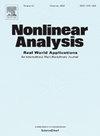求解浅水方程组的无网格几何守恒加权最小二乘法
IF 1.8
3区 数学
Q1 MATHEMATICS, APPLIED
引用次数: 0
摘要
对浅水方程进行数值求解,模拟自由水面流动。浅水方程中的对流通量项需要用Riemann解算器进行离散,以捕捉某些流动情况下的激波和不连续,如水力跳跃、溃坝波传播或钻孔波传播、溃坝流等。近似黎曼解算器可以捕捉激波,是传统的基于网格的数值方法研究明渠流动动力学的常用方法。虽然无网格方法可以在高度不规则的几何结构上工作,而不涉及复杂的网格生成过程,但激波捕获能力尚未实现,特别是在求解明渠流动时。因此,我们提出了一种求解浅水方程的数值方法,即无网格冲击捕获几何守恒加权最小二乘(GC-WLS)方法。在提出的无网格方法框架内实现了HLL (Harten-Lax-Van Leer) Riemann求解器。利用GC-WLS方法计算了浅水方程的空间导数和高阶精度的保守变量重构。提出的无网格方法在各种具有数值挑战性的明渠流动问题上进行了测试,包括分析,实验室实验和溃坝事件的大规模物理模型研究。本文章由计算机程序翻译,如有差异,请以英文原文为准。
A meshless geometric conservation weighted least square method for solving the shallow water equations
The shallow water equations are numerically solved to simulate free surface flows. The convective flux terms in the shallow water equations need to be discretized using a Riemann solver to capture shocks and discontinuity for certain flow situations such as hydraulic jump, dam-break wave propagation or bore wave propagation, levee-breaching flows, etc. The approximate Riemann solver can capture shocks and is popular for studying open-channel flow dynamics with traditional mesh-based numerical methods. Though meshless methods can work on highly irregular geometry without involving the complex mesh generation procedure, the shock-capturing capability has not been implemented, especially for solving open-channel flows. Therefore, we have proposed a numerical method, namely, a shock-capturing meshless geometric conservation weighted least square (GC-WLS) method for solving the shallow water equations. The HLL (Harten–Lax–Van Leer) Riemann solver is implemented within the framework of the proposed meshless method. The spatial derivatives in the shallow water equations and the reconstruction of conservative variables for high-order accuracy are computed using the GC-WLS method. The proposed meshless method is tested for various numerically challenging open-channel flow problems, including analytical, laboratory experiments, and a large-scale physical model study on dam-break event.
求助全文
通过发布文献求助,成功后即可免费获取论文全文。
去求助
来源期刊
CiteScore
3.80
自引率
5.00%
发文量
176
审稿时长
59 days
期刊介绍:
Nonlinear Analysis: Real World Applications welcomes all research articles of the highest quality with special emphasis on applying techniques of nonlinear analysis to model and to treat nonlinear phenomena with which nature confronts us. Coverage of applications includes any branch of science and technology such as solid and fluid mechanics, material science, mathematical biology and chemistry, control theory, and inverse problems.
The aim of Nonlinear Analysis: Real World Applications is to publish articles which are predominantly devoted to employing methods and techniques from analysis, including partial differential equations, functional analysis, dynamical systems and evolution equations, calculus of variations, and bifurcations theory.

 求助内容:
求助内容: 应助结果提醒方式:
应助结果提醒方式:


